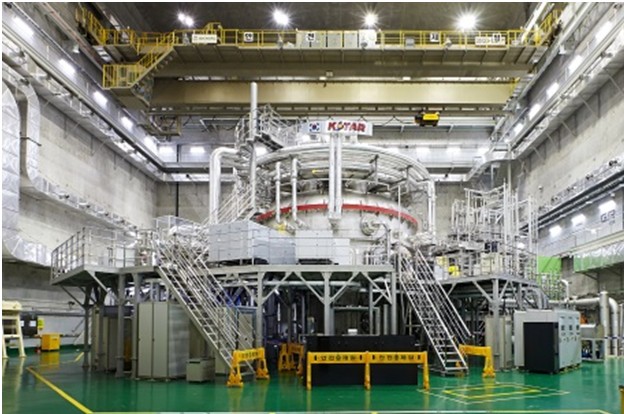
The Korean Superconducting Tokamak Advanced Research (KSTAR) tokamak-type nuclear fusion reactor has achieved a world record of 70 seconds in high-performance plasma operation, South Korea's National Fusion Research Institute (NFRI) has announced.

The institute, based at Daejeon, 160 km south of Seoul, said a fully non-inductive operation mode - called a "high poloidal beta scenario" - has been used to achieve this long and steady state of operation using high-power neutral beam. It said various techniques, including a rotating 3D field, have been applied to alleviate the accumulated heat fluxes on the plasma-facing components.
"The world record for high-performance plasma for more than a minute demonstrated that the KSTAR is the forefront in steady-state plasma operation technology in a superconducting device," NFRI said in a statement today. "This is a huge step forward for realization of the fusion reactor."
In addition, the institute said, KSTAR researchers also succeeded in achieving an alternative advanced plasma operation mode with the internal transport barrier (ITB). This is a steep pressure gradient in the core of the plasmas due to the enhanced core plasma confinement. NFRI said this is the first ITB operation achieved in the superconducting device at the lowest heating power.
"With the progress of the Iter project, the KSTAR research will focus on the mission essential for the fusion reactor beyond Iter," the institute said. "They are new efficient mode of operation and a new divertor concept suitable for the Korean fusion demonstration reactor, the K-DEMO device, which will be the first runner in worldwide fusion energy development plan."
NFRI president Keeman Kim said, "We will exert efforts for KSTAR to continuously produce world-class results, and to promote international joint research among nuclear fusion researchers."
The research team around Anton Zeilinger has succeeded in breaking two novel records while experimenting with so-called twisted particles of light. In one experiment, the scientists could show that the twist of light itself, i.e. the screw-like structure, is maintained over a free-space propagation of 143 kilometers, which could revolutionize future data transmission. In the second study, the researchers teamed up with an Australian research group to twist individual light quanta stronger than ever before while even preserving quantum entanglement with a second particle. Similarly, these results, now published in the highly renowned journal PNAS, are not only of fundamental interest but also give a hint towards the enormous information capacity a single particle of light may offer in future applications.
Twisted light
Time and again, properties of the light surprise the research world. For example, light can be brought into a corkscrew-like form in order to produce so-called "screws of light", as Anton Zeilinger, quantum physicist at the University of Vienna, describes. The amazing fact is that one can in principle impose any number of windings on each individual light particle – called photons. The larger the number of windings, the larger the so-called quantum number with which the photon is described. The Viennese scientists results of the Vienna Center for Quantum Science and Technology (VCQ) at the University of Vienna and the Institute of Quantum Optics and Quantum Information Vienna (IQOQI Vienna) at the Austrian Academy of Sciences have now made use of this feature in two papers, breaking previous records on the transmission distance and the magnitude of the quantum number.
Twisted light transmitted message over 143 kilometers
In principle, twisted light can carry an arbitrary large amount of information per photon. This is in contrast to the polarization of light, which is limited to one bit per photon. For example, data rates of up to 100 terabits per second, which correspond to about 120 Blu-Ray discs per second, have already been achieved under laboratory conditions. The transmission under realistic conditions, however, is still in its infancy. In addition to transmission over short distances in special fiber optics, transmission of such light beams over free space, required for instance for satellite communication, was limited to three kilometers so far; achieved by the same Viennese team two years ago (https://www.youtube.com/watch?v=OEupkfMqKGY).
In the current study, the research team around Anton Zeilinger and Mario Krenn show that information encoded in twisted light can still be reconstructed even after more than 100 kilometers. The experiment has been conducted between the canary islands of La Palma and Tenerife, which is 143 kilometer away. "The message 'Hello World!' has been encoded onto a green laser with an optical hologram, and reconstructed with an artificial neural network on the other island", explains Krenn, PhD-student in Zeilinger’s group. Having shown that these light properties are in principle maintained over long distances, they now have to be combined with modern communication technologies – a task which already several groups around the world are starting to address.